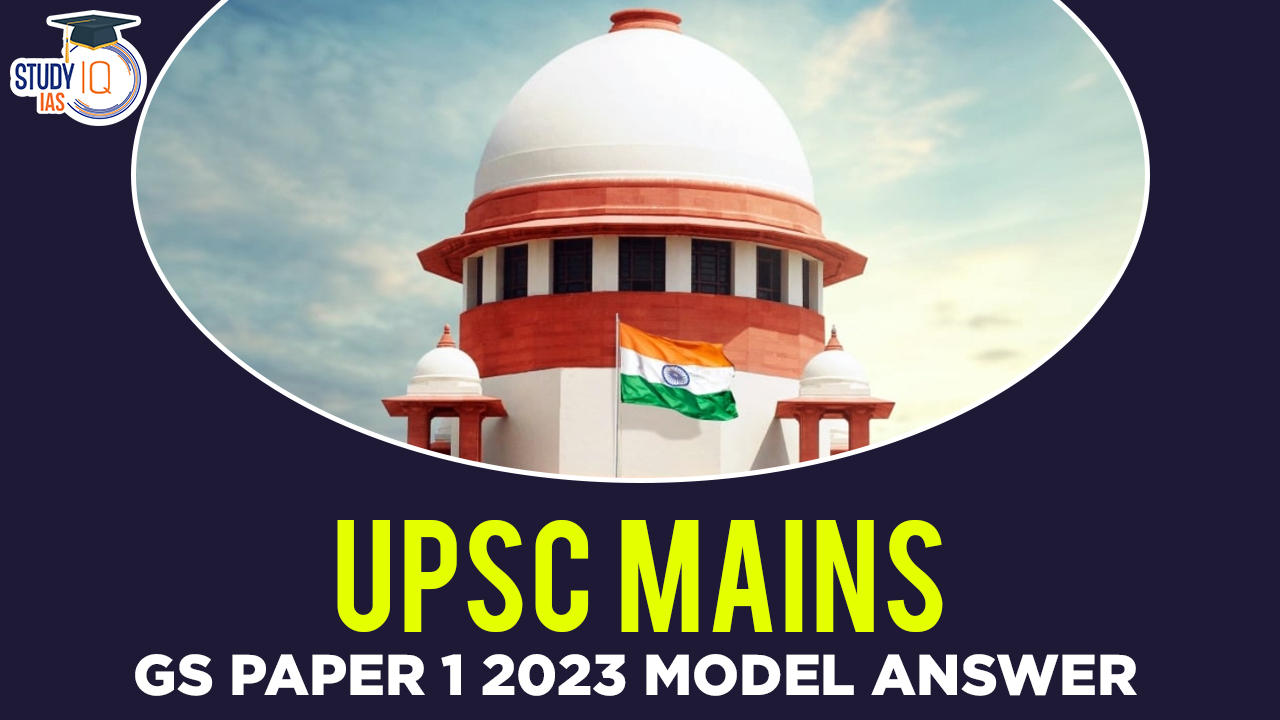Q12. What were the major technological changes introduced during the Sultanate period? How did those technological changes influence the Indian society? (15 M)- History
सल्तनत काल के दौरान किये गये बड़े तकनीकी बदलाव क्या थे? उन तकनीकी बदलावों ने भारतीय समाज को कैसे प्रभावित किया था?
Introduction:
The introduction can include – time period of Sultanate, and that the technological advancements brought by them ended the so-called dark ages in India. Also, add 1 line on how technological advancement led to economic progress which ultimately led to societal flourishment.
Body:
Major Technological Changes Introduced during the Sultanate Period:
|
Technologies Introduced |
Impact on Indian Society |
| Agriculture |
Persian Wheel
Gaz-i-sikandari |
- Introduction of the Persian wheel substantially increased agricultural productivity.
- It evolutionized irrigation, allowing farmers to cultivate larger areas and grow more diverse crops.
- The increased yield contributed to surplus food production, trade, and economic prosperity in medieval India.
- The ‘gaz-i-sikandari’ was an instrument for measuring land which made revenue collection more efficient.
|
| Textile |
Spinning wheel (charkha), Pit loom, Drawloom. |
- The use of the spinning wheel increased the production of yarn by six times.
- Pit loom was introduced in India during the fifteenth century, which speeded up the process of weaving.
- Drawloom was another important weaving device which was used for simultaneous patterned weave of different colours.
- These innovations bolstered the textile industry, creating employment opportunities and a flourishing trade network.
- Regions like Gujarat became renowned for their intricate textiles, attracting traders from afar.
|
| Metallurgy |
Employment of vertical bore pits, deep mines with oval shafts, use of pulley etc. |
- Advanced mining techniques improved metal production, benefiting toolmaking and weaponry.
- The Delhi Sultanate’s armor and weaponry production thrived due to these innovations which led them to form vast Indian empire and this political unity provided peace and stability thus benifiting society.
|
| Paper Making |
Use of paper and technique of bookbinding |
- Knowledge Dissemination: The adoption of paper and bookbinding techniques facilitated the spread of education, culture, and administrative record-keeping.
- The era of record keeping and Historiography started in India with the advent of the Delhi Sultanate.
- Paper was more durable and long lasting then birch bark.
- Persian and Arabic texts were translated into local languages, broadening access to literature and learning.
|
| Wine Distillation |
Wine distillation started using the fermentation method |
- Culinary Diversity: Wine distillation diversified culinary practices, leading to the creation of various alcoholic beverages.
- Example: Distilled spirits like arak and arrack became popular regional drinks.
- This also increased revenue for the state but at the same it also caused more chaos in the society. So much so that, Alludin Khilji attempted to ban liquor consumption in his empire.
|
| Silk Production |
Silk production started in Bengal. Muslin was another famous product of Bengal. |
- Economic Flourishing: Bengal’s silk and muslin production boosted its economy and trade connections.
- The exquisite Bengali muslin textiles were in high demand globally, enriching both Bengal and India’s medieval trade.
- It flourished so much in medieval times that when Europeans came to India, Bengal was the richest provine of India.
|
| Construction |
Use of arch & dome started. It led to a massive boom in construction activities under the Sultans of Delhi. New materials like gypsum and lime paste were used for plastering buildings. Lime as cementing agent (mortar) began. |
- Arcuate style of architecture started in india also known as Indo-Islamic architecture.
- Architectural Fusion: Indo-Islamic architecture combined Islamic and Indian styles, seen in structures like the Qutub Minar.
- Innovative Features: The use of arches, domes, and intricate geometric patterns influenced Indian architecture.
- Societal Integration: It promoted cultural and religious exchange, exemplified by structures like the Taj Mahal.
- Urban Planning: Cities like Delhi showcased grid-like layouts and grand mosques. This became prototype for development of other cities.
- Symbol of Power: Monumental buildings became symbols of political and cultural authority in medieval India.
- Example: The Qutub Minar and Alai Darwaza in Delhi exemplify the architectural grandeur of the Delhi Sultanate period.
|
Conclusion:
Conclusion 1 – These technological changes during the medieval era under the Delhi Sultanate had a profound impact on Indian society. They fueled economic growth, cultural exchange, and technological advancements, contributing to the flourishing of medieval India as a diverse and dynamic civilization.
Conclusion 2 – These innovations further laid the foundation for future developments during the Mughal and colonial periods
Check out the UPSC Mains GS Paper 1 2023 Analysis with detailed expatiation of the topics of Mains GS Paper 1 By the Study IQ Experts.
Sharing is caring!





















 WhatsApp
WhatsApp